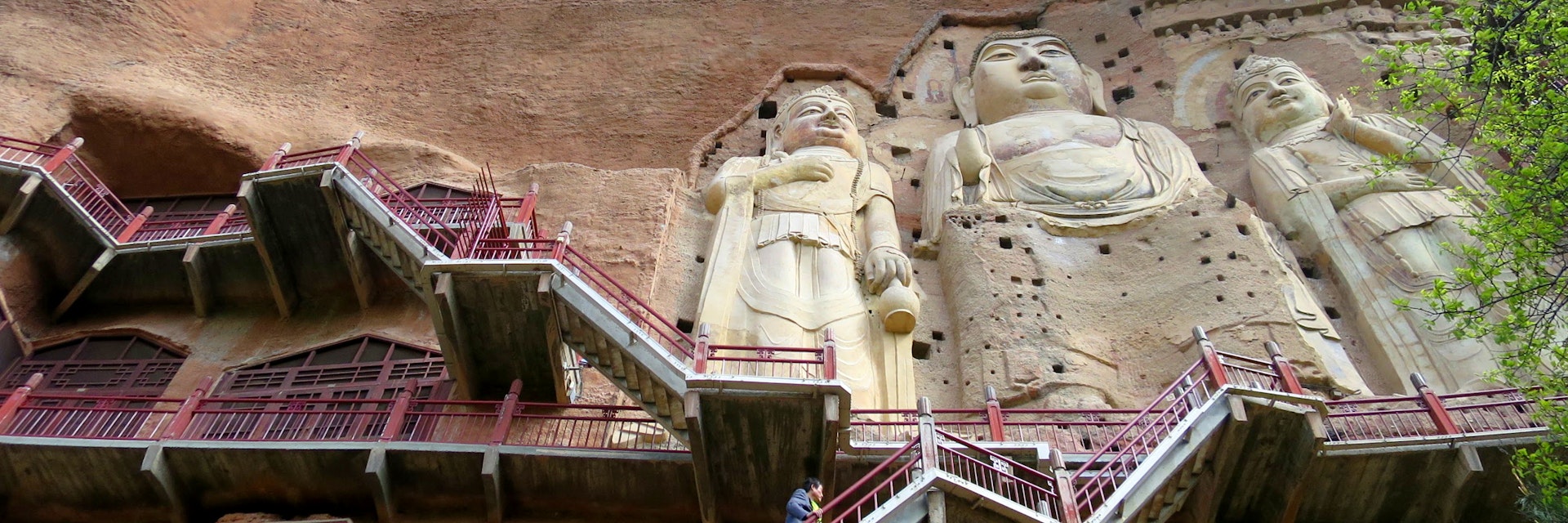Set among wild, green mountains southeast of Tianshui, the grottoes of Maijishan hold some of the most famous Buddhist rock carvings along the Silk Road. The cliff sides of Maijishan are covered with 221 caves holding more than 7800 sculptures carved principally during the Northern Wei and Zhou dynasties (AD 386–581). The rock face rises in a steep ascent, with the hundreds of grottoes connected by a series of constructed walkways clinging to the sheer cliff.
Within the hard-to-miss Sui dynasty trinity of Buddha and two Bodhisattvas is the largest statue on the mountain: the cave’s central effigy of Buddha tops out at 15.7m. During restoration works on the statue in the late 1980s, a handwritten copy of the Sutra of Golden Light was discovered within the Buddha’s fan.
Vertigo-inducing catwalks and steep stairways cling to the cliff face, affording close-ups of the art. It’s not certain just how the artists managed to clamber so high; one theory is that they created piles from blocks of wood reaching to the top of the mountain before moving down, gradually removing them as they descended.
A considerable amount of pigment still clings to many of the statues – a lot of which are actually made of clay rather than being hewn from rock – although you frequently have to climb up steps to peer at them through tight mesh grills with little natural illumination; sometimes it can be hard to see much, but other statues are as clear as day. Most of the more impressive sculptures decorate the upper walkways, especially at cave 4.
A new visitor centre, complete with post office and rather spooky face recognition technology, has gone up 3km from the grottoes, meaning that you still have to walk this distance uphill to get to the statuary, or you can take one of the sightseeing buses (观光车, guānguāng chē; ¥15) that regularly depart from the road just beyond the ticket office.
An English-speaking guide charges ¥50 for a group of up to five. It may be possible to view normally closed caves (such as cave 133) for an extra fee of ¥500 per group.
The admission ticket includes entry to Ruiying Monastery (瑞应寺, Ruìyìng Sì), at the base of the mountain, which acts as a small museum of selected statues. Across from the monastery is the start of a trail to a botanic garden (植物园, zhíwùyuán), which allows for a short cut back to the entrance gate through the forest.
The grottoes are the highlight of the much larger Maijishan Scenic Area (麦积山景区, Màijīshān Jǐngqū), which has considerable hiking potential if you want to make a day of it, passing waterfalls, observation terraces, mountains, valleys and temples. One activity is climbing Xiāngjí Shān (香积山); for the trailhead, head back towards the visitor centre where the sightseeing bus drops you off and look for a sign to the hill down a side road to the left. You can purchase a cheaper ticket (¥25) for just the scenic area if you wish, but it will not permit you to visit the grottoes.
If you're hungry, there's a huge collection of stalls serving noodles and other local dishes near the ticket office. Most dishes are priced at ¥10.
To reach Maijishan, take bus 34 (¥5 one way, one hour, every 15 minutes) from the bus shelter in the southeast corner of Tianshui Railway Station. The bus terminates at the Maijishan ticketing office. At the time of writing, the road to the grottoes was being much widened to accommodate a greater volume of vehicle traffic to the sight.

